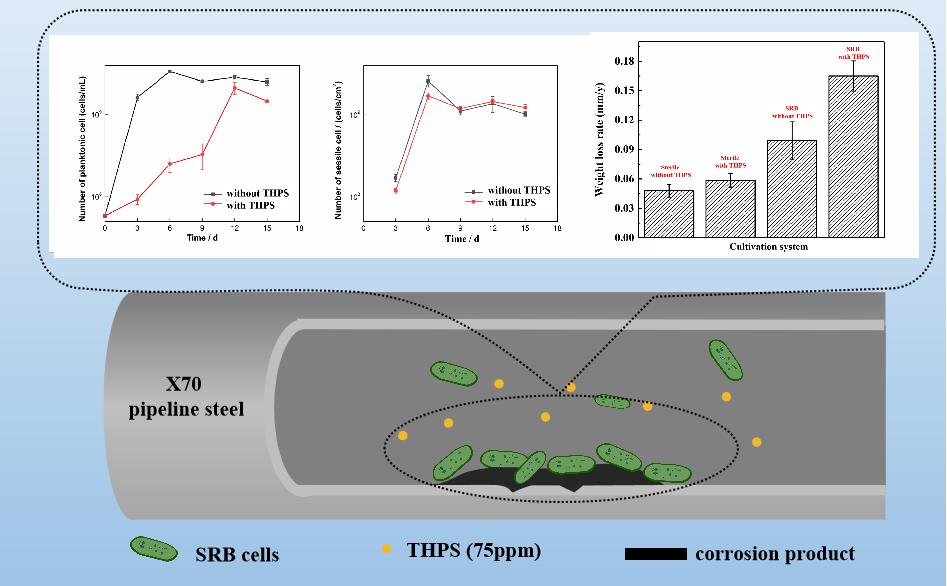Almost all materials immersed in seawater are suffering from microbiologically influenced corrosion (MIC) all the time. MIC catalyzed by sulfate reducing bacteria (SRB) is one of the main causes of pipeline network damage, leading to great economic losses as well as environmental issues.
The non-oxidizing biocide tetrakis hydroxymethyl phosphonium sulfate (THPS) is widely used as one of the MIC control measures in industry, including marine oil and gas industry. A long-term application of large amounts of chemical biocides not only causes environmental pollution, but also enhances the microbial resistance to biocides, thus weakening the protection of metal materials from microbial corrosion.
However, it remains unclear how SRB cells attached to metal surfaces (and potentially forming biofilms) respond to a biocide treatment and how the resulting MIC is affected.
Recently, the research team led by Prof. DUAN Jizhou from the Institute of Oceanology, Chinese Academy of Sciences (IOCAS), provided new insight into the biofilm formation and corrosion mechanism of pipeline steel under a tolerated THPS concentration for Desulfovibrio hontreensis (D. hontreensis) SY-21.
The study was published in Bioelectrochemistry.
Researchers found that inadequate dosing of THPS treatment (75ppm) increased MIC of X70 pipeline steel induced by D.hontreensis SY-21.
The tolerated THPS concentration of D. hontreensis SY-21 was determined via culturing on culture media plates with different THPS concentrations. The concentration of 75 ppm THPS was found to be the tolerated THPS concentration for D. hontreensis SY-21, as a strong inhibitory effect on the growth of D. hontreensis, without suppressing it completely, was observed at this biocide concentration.
The effect of THPS on SRB cell counts was analyzed via counting planktonic and sessile cells with or without THPS. THPS delayed and partially inhibited the growth of planktonic cells of D.hontreensis, while the number of bacteria was not affected by THPS addition.
The weight loss of coupons in SRB media with or without the addition of THPS was 0.165±0.015 mm/y and 0.100±0.019 mm/y, respectively. The steel weight loss was about 65% higher (p-value = 0.0007) in the biotic assays when THPS was added (compared to the mean determined in biotic systems without THPS).
"THPS concentrations with THPS (75 ppm) addition increased the corrosive effect of the presence of D. hontreensis by promoting the growth of sessile cells and biofilm formation," said Prof. DUAN.
Therefore, the use of the biocide in practical applications needs to be properly considered and managed.
This work was supported by the National Natural Science Foundation of China and National Natural Science Foundation of China for Exploring Key Scientific Instrument.

The illustration image of the MIC mechanism of pipeline steel under a tolerated THPS concentration (75 ppm) for D. hontreensis SY-21
Liting Xu, Fang Guan, Yan Ma, Ruiyong Zhang*, Yimeng Zhang, Xiaofan Zhai, Xucheng Dong, Yanan Wang, Jizhou Duan*, Baorong Hou. (2022). Inadequate dosing of THPS treatment increases microbially influenced corrosion of pipeline steel by inducing biofilm growth of Desulfovibrio hontreensis SY-21. Bioelectrochemistry, 145: 108048.
DUAN Jizhou
Institute of Oceanology
E-mail: duanjz@qdio.ac.cn
(Editor: ZHANG Yiyi)
|
|

Address: 7 Nanhai Road, Qingdao, Shandong 266071, China
Tel: 86-532-82898902 Fax: 86-532-82898612 E-mail: iocas@qdio.ac.cn


